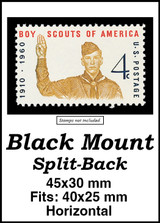U.S. #1193
1962 4¢ Project Mercury
Issue Date: February 20, 1962
City: Cape Canaveral, Florida
Quantity: 289,240,000
Printed By: Bureau of Engraving and Printing
Printing Method: Giori Press
Perforations: 1... more
U.S. #1193
1962 4¢ Project Mercury
Issue Date: February 20, 1962
City: Cape Canaveral, Florida
Quantity: 289,240,000
Printed By: Bureau of Engraving and Printing
Printing Method: Giori Press
Perforations: 11
Color: Dark blue and yellow
U.S. #1193 features the “Friendship 7” space capsule flown by John Glenn in the first successful orbit of the Earth. The mission was the result of a secret project run by the Post Office Department. The Post Office had recently (at the time) started using a Giori Printing Press, which allowed it to produce stamps in two or three colors in a single run (instead of having to send the stamps through for each color).
First American Orbit Of Earth
On February 20, 1962, John Glenn became the first American to orbit the Earth aboard his Friendship 7 capsule.
Born on July 18, 1921, in Cambridge, Ohio, John Glenn was enrolled in college when World War II began. Because he had earned his private pilot’s license, he enlisted in the Army Air Corps. He wasn’t called up quickly, so he joined the Navy in March 1942. He was reassigned to the Marines in 1943 and flew 59 combat missions in the South Pacific.
Glenn continued to defend our country during the Korean War. He flew 63 missions and returned to his base twice with more than 250 enemy anti-aircraft bullet holes in his plane.
Flying was a passion for Glenn and during peacetime, he was appointed to test pilot school. He completed the first coast-to-coast supersonic flight on July 16, 1957. Glenn received his fifth Distinguished Flying Cross for the successful mission, named “Project Bullet.” Less than two years later, Glenn would start training for another historic flight.
In April 1959, seven men were chosen to take part in the National Aeronautics and Space Administration’s (NASA) Project Mercury, and John Glenn was one of them. He was selected for the Mercury-Atlas 6 mission to become the first American to orbit the Earth. On February 20, 1962, Glenn climbed into the Friendship 7 spacecraft and launched from Cape Canaveral, Florida. He broke through Earth’s atmosphere and circled the globe for four hours, 55 minutes. Glenn made three orbits before a heating problem forced an early landing. Upon his return, astronaut John Glenn was a national hero, with his own ticker-tape parade and a service medal awarded by President Kennedy.
Glenn must have thought his space flight days were over when he resigned from NASA shortly after his friend John Kennedy was assassinated. The former astronaut began his political career in 1974 when he was elected to represent his home state of Ohio in the US Senate. When most people are slowing down and enjoying their twilight years, Glenn was asked to return to space. On October 29, 1998, the Space Shuttle Discovery blasted off with Glenn aboard. At age 77, Glenn became the oldest person to go into space. When he returned to earth, another ticker-tape parade was held in his honor.
In the early 1960s, the Post Office started using a Giori Printing Press, which allowed it to produce stamps in two or three colors in a single run (instead of having to send the stamps through for each color). In the summer of 1961, the Post Office Department began a special project. The new Giori Press was locked in a separate room accessed only by a small number of postal employees and with a guard to keep others out. Rumors in the department speculated that it was being used to make currency. Instead, it was printing the “Project Mercury” stamp.
The stamp was sent in sealed packets to postmasters in 305 locations around the country, with specific instructions: “Classified Material. Do Not Open.” The packets were shipped in time for the original launch date – December 21, 1961. Weather caused delays until the end of February.
The February 20 launch was at 9:48 a.m. local time in Cape Canaveral, Florida, and splashed down at 2:43 p.m. At 3:30 p.m., the post offices were informed by telephone, teletype, and telegraph, that they could open the packet and distribute the stamps. If there had been a failure, the stamps would not have been released.
One side effect of the late release was that it gave very limited time to get First Day Covers serviced – an hour and a half, in Eastern states. Cape Canaveral is listed as the official site of the First Day of Issue. There was no Cape Canaveral Post Office until 3:30 p.m., February 20, 1962. That’s when a US Air Force van was made into a temporary post office and called a substation of the Cocoa, Florida, Post Office.
Click here to watch a video of the Friendship 7 launch plus photos and audio from the orbit.
Less 